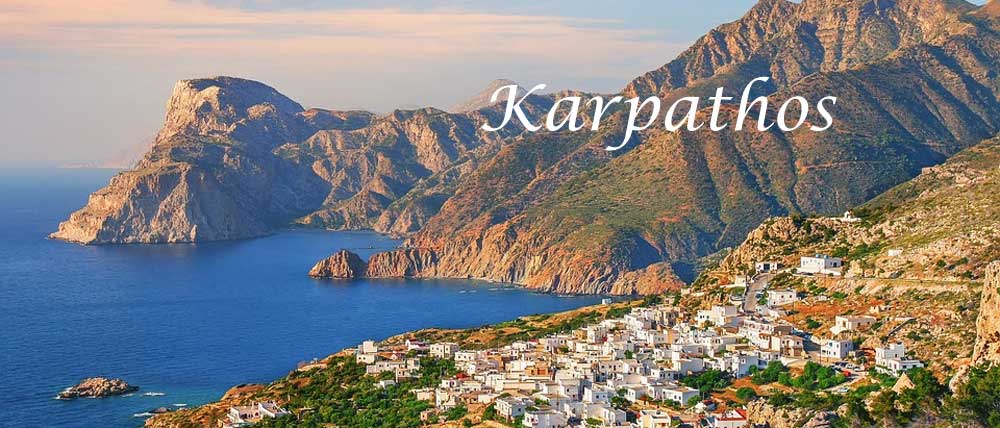The village of Olympos in Karpathos
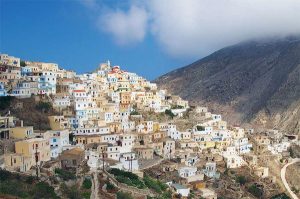 Olympos is one of the most beautiful and renowned settlements of Karpathos, is situated in the northern part of the island, approximately a one-and-a-half-hour drive from Pigadia. Built on a steep hillside, offering a postcard-perfect and picturesque view.
Olympos is one of the most beautiful and renowned settlements of Karpathos, is situated in the northern part of the island, approximately a one-and-a-half-hour drive from Pigadia. Built on a steep hillside, offering a postcard-perfect and picturesque view.
Olympos is still recognized today as one of the most traditional settlements not only on the island of Karpathos but in all of Greece. Often referred to simply as ‘Olympos, the Living Ethnographic Museum of Karpathos,’ the residents of Olympos continue to faithfully preserve their traditions.
For centuries, Olympos (Olymbos, Όλυμπος) remained one of the most isolated towns on the island of Karpathos. Initially, a narrow and poorly maintained path led to the settlement from the south, particularly from Pigadia, and only in recent decades have wider roads been constructed. It took the last decade for a high-quality asphalt strip, although narrow and winding in some mountainous sections, to connect Olympos with the southern parts of Karpathos, including the capital and the airport.
In contemporary times, Olympos can be reached in various ways on Karpathos: by car, motorcycle, local bus departing from Pigadia, and even through boat excursions that bring guests to the nearby port of Diafani, where a bus further transports them. Those staying in Pigadia or Amoopi and planning to explore Olympos will find it convenient that boats depart from the main port of the capital.
Attractions of Olympos
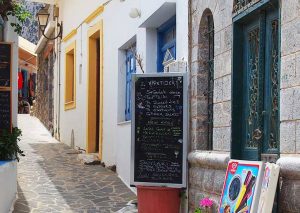 Nestled among traditionally built stone houses in various vibrant colors, Olympos boasts flower-adorned, winding streets. As you ascend, the views of the surrounding countryside become increasingly breathtaking. More than 70 smaller and larger windmills can be discovered at the highest points of Olympos, although only a few still operate regularly today – the blades have been removed from most, leaving behind only the empty structures.
Nestled among traditionally built stone houses in various vibrant colors, Olympos boasts flower-adorned, winding streets. As you ascend, the views of the surrounding countryside become increasingly breathtaking. More than 70 smaller and larger windmills can be discovered at the highest points of Olympos, although only a few still operate regularly today – the blades have been removed from most, leaving behind only the empty structures.
In the streets of Olympos, residents dressed in traditional attire can be seen sitting in front of their houses, with Olympos women being particularly notable for their distinctive, brightly decorated clothing. Olympos is often referred to as a living ethnographic museum due to this characteristic, and while nowadays the traditional costumes are mainly worn for the sake of visitors, the locals still attach great importance to their traditions and preservation.
Since the 2000s, the increasing tourism has become the main livelihood for Olympos, with many tourists purchasing locally made weaves and handcrafted decorative items in the gift shops of this small Karpathian town.
What to See in Olympos
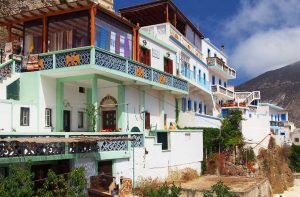 Contributing significantly to the charm of this town, known for preserving its traditions, is the fact that cars do not navigate the streets of Olympos. The narrow, winding, and mostly steep streets simply cannot accommodate vehicles. A spacious parking lot awaits vehicles, motorcycles, and participants in Olympos optional programs, and from here, visitors must ascend to the town on foot.
Contributing significantly to the charm of this town, known for preserving its traditions, is the fact that cars do not navigate the streets of Olympos. The narrow, winding, and mostly steep streets simply cannot accommodate vehicles. A spacious parking lot awaits vehicles, motorcycles, and participants in Olympos optional programs, and from here, visitors must ascend to the town on foot.
While strolling along the main pedestrian street of the town, one of Olympos’ most beautiful attractions is its most impressive church, with its bell tower towering above most buildings. Continuing from here, it is possible to walk to places offering splendid views: even narrower, alley-like paths and stairs branch out in all directions from the main street, leading between the buildings.
Due to the view of the Aegean Sea and the surrounding mountains of Karpathos, the town becomes a favorite for many. The panorama from the higher points, with the houses and the often flower-covered buildings, creates an exceptionally attractive image for those visiting.
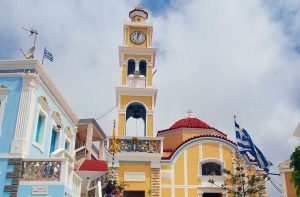
For a long time, the friendly seaside town of Diafani served as the maritime outlet and port for Olympos. Located 8 kilometers to the east, a good-quality but winding asphalt road connects the two settlements, allowing visitors to combine visits to both places. Diafani also serves as the second-largest port on the island of Karpathos after the capital, and for centuries, it was from here that supplies were brought up to the village. Nowadays, those arriving by boat to visit Olympos as part of an optional program embark on boats departing from Pigadia and, after docking in Diafani, continue their journey by bus.
Location and map of Olympos
